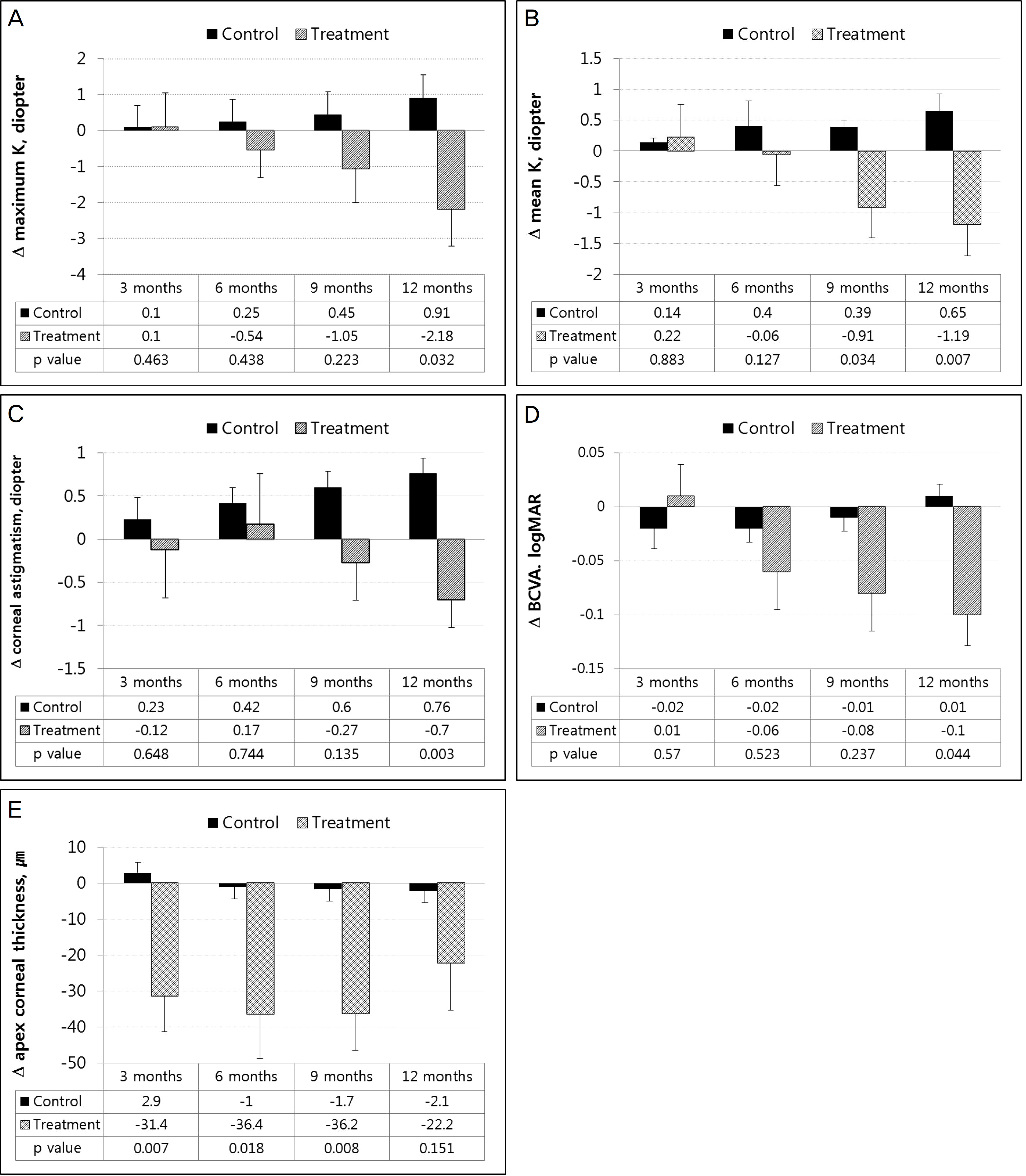J Korean Ophthalmol Soc.
2011 Jan;52(1):23-28. 10.3341/jkos.2011.52.1.23.
Clinical Results of Riboflavin and Ultraviolet-A-induced Corneal Cross-linking for Progressive Keratoconus in Korean Patients
- Affiliations
-
- 1Department of Ophthalmology, KyungHee University School of Medicine, Seoul, Korea. khjinmd@khmc.or.kr
- KMID: 2214133
- DOI: http://doi.org/10.3341/jkos.2011.52.1.23
Abstract
- PURPOSE
To report the clinical results of 10 progressive keratoconic eyes in Korean patients treated by corneal cross-linking and compare the progression of keratoconus in the fellow eyes.
METHODS
This present retrospective case series was comprised of 10 progressive keratoconic eyes (10 patients) that had corneal cross-linking. Patients were examined before corneal cross-linking as well as 1, 3, 6, 9, and 12 months postoperatively. The main outcome measures were best corrected visual acuity, maximum keratometry, mean keratometry, corneal thickness, corneal astigmatism and endothelial cell count.
RESULTS
The best corrected visual acuity (logMAR) improved from 0.60 +/- 0.39 to 0.52 +/- 0.38 at 12 months postoperatively. The maximum keratometry decreased from 62.39 +/- 8.82 D preoperatively to 60.21 +/- 9.21 D at 12 months postoperatively and the mean keratometry decreased from 51.59 +/- 5.86 D to 50.04 +/- 6.21 D at 12 months. In addition, the corneal thickness (at the thinnest area) decreased from 433.60 +/- 44.31 microm to 403.40 +/- 38.95 microm at 12 months. There was no statistically significant difference between the preoperative and 12 months postoperative endothelial cell count (p = 0.731).
CONCLUSIONS
This present 1-year follow-up study of Korean keratoconus patients showed corneal cross-linking appeared to be effective in the stabilizing progression of keratoconus and improving best corrective visual acuity and keratometry.
Keyword
MeSH Terms
Figure
Cited by 1 articles
-
Anterior Elevation Changes Following Corneal Crosslinking for Keratoconus
Ji Ho Yang, Kyung Hyun Jin
J Korean Ophthalmol Soc. 2013;54(2):199-209. doi: 10.3341/jkos.2013.54.2.199.
Reference
-
References
1. Wollensak G. Crosslinking treatment of progressive keratoconus: new hope. Curr Opin Ophthalmol. 2006; 17:356–60.
Article2. Raiskup-Wolf F, Hoyer A, Spoerl E, Pillunat LE. Collagen crosslinking with riboflavin and ultraviolet-A light in keratoconus: long-term results. J Cataract Refract Surg. 2008; 34:796–801.
Article3. Kim HS, Lee TH, Lee KH. Intracorneal ring segment implantation for the management of keratoconus: short-term safety and efficacy. J Korean Ophthalmol Soc. 2009; 50:1505–9.
Article4. Wollensak G, Spoerl E, Seiler T. Stress-strain measurements of human and porcrine cornea after riboflavin/ultraviolet-A-induced crosslinking. J Cataract Refract Surg. 2003; 29:1780–5.5. Wollensak G, Wilsch M, Spoerl E, Seiler T. Collagen fiber diameter in the rabbit cornea after collagen crosslinking by riboflavin/ UVA. Cornea. 2004; 23:503–7.6. Spoerl E, Wollensak G, Seiler T. Increased resistance of cross-linked cornea against enzymatic digestion. Curr Eye Res. 2004; 29:35–40.
Article7. Mencucci R, Marini M, Paladini I, et al. Effects of riboflavin/UVA corneal crosslinking on keratocytes and collagen fibres in human cornea. Clin Experiment Ophthalmol. 2010; 38:49–56.
Article8. Wollensak G, Spoerl E, Seiler T. Riboflavin/Ultraviolet-A-induced collagen crosslinking for the treatment of keratoconus. Am J Ophthalmol. 2003; 135:620–7.
Article9. Wittig-Silva C, Whiting M, Lamoureux E, et al. A randomized controlled trial of corneal collagen crosslinking in progressive keratoconus: preliminary results. J Refract Surg. 2008; 24:s720–5.
Article10. Grewal DS, Brar GS, Jain R, et al. Corneal collagen crosslinking using riboflavin and ultraviolet-A light for keratoconus: one-year analysis using Scheimpflug imaging. J Cataract Refract Surg. 2009; 35:425–32.11. Vinciguerra P, Albe E, Trazza S, et al. Refractive, topographic, tomographic, and abberometric analysis of keratoconic eyes undergoing corneal crosslinking. Ophthalmology. 2009; 116:369–78.12. Koller T, Iseli HP, Hafezi F, et al. Scheimpflug imaging of corneas after collagen crosslinking. Cornea. 2009; 28:510–5.
Article13. Vinciguerra P, Albe E, Trazza S, et al. Intraoperative and postoperative effects of corneal collagen crosslinking on progressive keratoconus. Arch Ophthalmol. 2009; 127:1258–65.
Article14. Caporossi A, Mazzotta C, Baiocchi S, Caporossi T. Long-term results of riboflavin ulatraviolet A corneal collagen crosslinking for keratoconus in Italy: the Seina eye cross study. Am J Ophthalmol. 2010; 149:585–93.15. Choi HJ, Kim MK, Lee JL. Diagnostic criteria for keratoconus using Orbscan II slit scanning topography/pachymetry system. J Korean Ophthalmol Soc. 2004; 45:928–35.16. Tu KL, Aslanides M. Orbscan II anterior elevation changes following conrneal collagen crosslinking treatment for keratoconus. J Refract Surg. 2009; 25:715–22.17. Spoerl E, Mrochen M, Sliney D, et al. Safety of UVA-riboflavin crosslinking of the cornea. Cornea. 2007; 26:385–9.
Article18. Bakke EF, Stojanovic A, Chen X, Drolsum L. Penetration of riboflavin and postoperative pain in corneal collagen crosslinking. Excimer laser superficial versus mechanical full-thickness epithelial removal. J Cataract Refract Surg. 2009; 35:1363–6.19. Kymionis GD, Kounis GA, Portaliou DM, et al. Intraoperative pachymetric measurements during corneal collagen crosslinking with riboflavin and ultraviolet a irradiation. Ophthalmology. 2009; 116:2336–9.
Article20. Koller T, Mrochen M, Seiler T. Complication and failure rates after corneal crosslinking. J Cataract Refract Surg. 2009; 35:1358–62.
Article21. Kymionis GD, Kontadakis GA, Kounis GA, et al. Simultaneous topography-guided PRK followed by corneal collagen crosslinking for keratoconus. J Refract Surg. 2009; 25:s807–11.
Article22. Chan CC, Sharma M, Wachler BS. Effect of inferior-segment intacs with and without C3-R on keratoconus. J Cataract Refract Surg. 2007; 33:75–80.
Article
- Full Text Links
- Actions
-
Cited
- CITED
-
- Close
- Share
- Similar articles
-
- The Long-term Clinical Outcome after Corneal Collagen Cross-linking in Korean Patients with Progressive Keratoconus
- The Intraoperative Corneal Pachymetry Changes during Accelerated Corneal Cross-linking in Progressive Keratoconus Patients with Thin Corneas
- Long-term Effects and Prognostic Factors of Accelerated Cross-Linking with Retention Ring-assisted Riboflavin Application on Keratoconus Progression
- Ten-year Results after Conventional Corneal Cross-linking in Korean Patients with Progressive Keratoconus
- Changes in Corneal Keratometry Readings after Corneal Collagen Cross-Linking Using Alcohol in Keratoconus Patients


